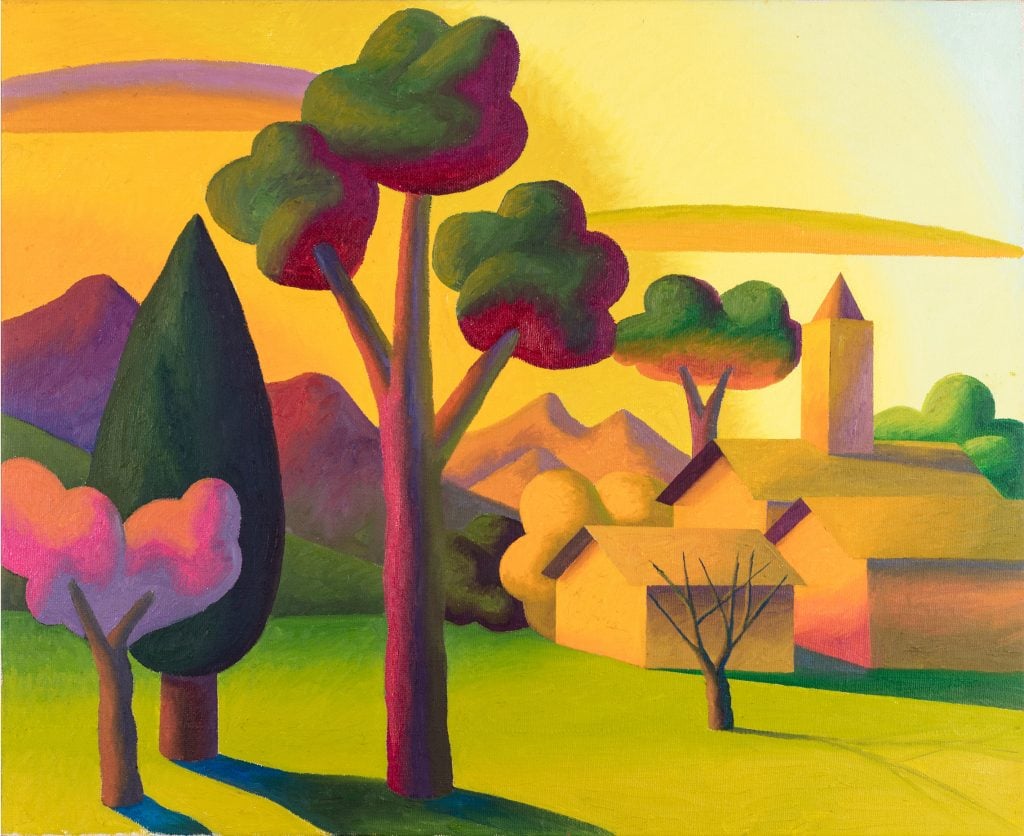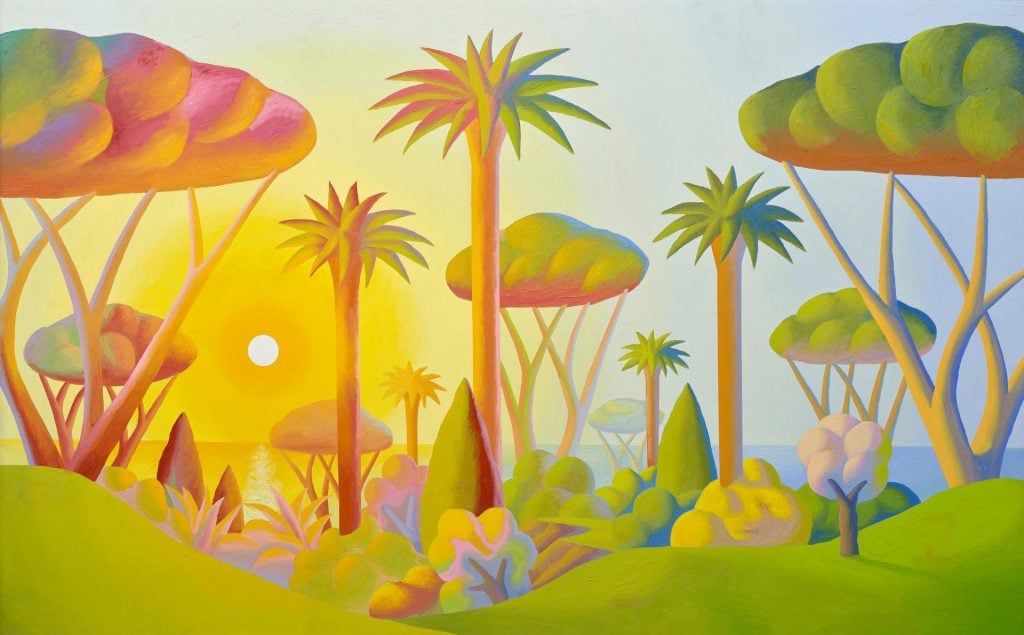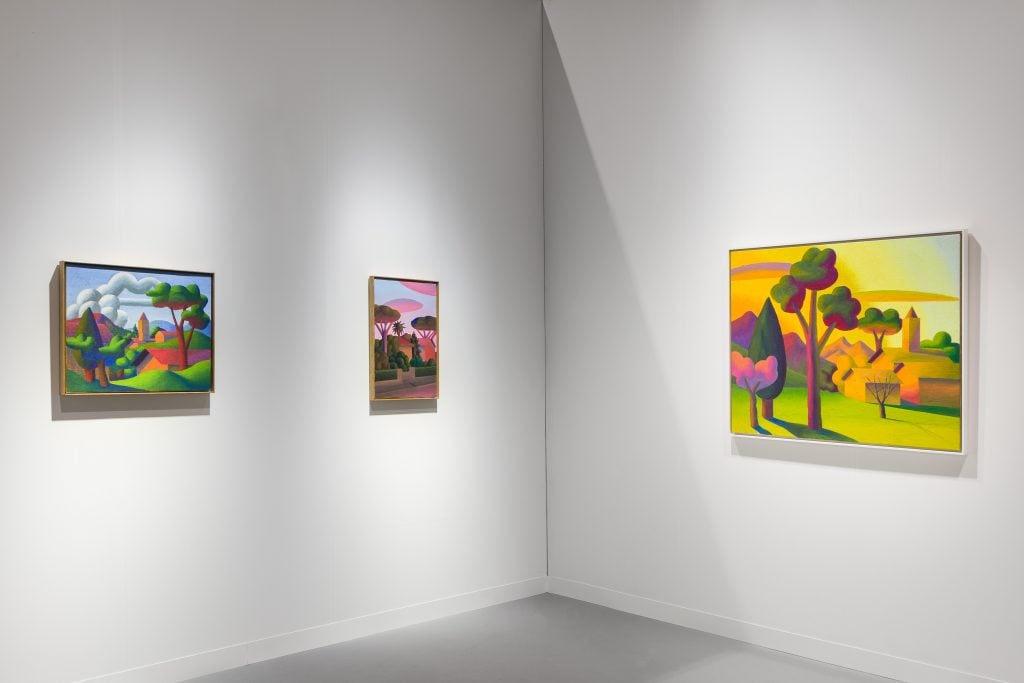Market
How the Late Italian Painter Salvo Went From Also-Ran to Market Star
His dreamy landscapes have inspired Nicolas Party; smart management of his estate has helped earn new admirers.

His dreamy landscapes have inspired Nicolas Party; smart management of his estate has helped earn new admirers.

Vivienne Chow

Two decades ago, when the mononymous Italian artist Salvo was in his mid-50s, the market for his alluring and vividly colored landscapes was decidedly mediocre, with his average price at auction hovering in the high four figures. Fast forward to today, and his work is in high demand, even at a moment when the contemporary field is experiencing a downturn.
Salvo’s works have been hanging in booths at leading art fairs of late and selling well on the auction block. Last year, his auction record was set at Christie’s Hong Kong, when his large 1994 canvas Il Mattino (The Morning) sold for more than $1.1 million (HK$8.7 million), some 210 percent above its presale estimate.
Even “ten years ago, Salvo was practically unknown outside of Italy,” Manuel Gerber, a partner at the Zurich-based art advisory Gerber & Stauffer Fine Arts, said. “There was only a very small number of dedicated international collectors, many of them in Switzerland. When we showed his work to clients or friends at the time, we’d get blank or puzzled looks back at best, appalled incomprehension at worst.”

Salvo, Il Mattino (The Morning), 1994. Courtesy of Christie’s.
Things began to change after Salvo’s death in 2015, at the age of 68, Gerber noted. The following year, his estate established the Archivio Salvo, a nonprofit to preserve and promote his legacy, and it helped build a solid lineup of institutional and gallery shows in subsequent years. Meanwhile, ultra-contemporary stars like Nicolas Party and Jonathan Monk have incorporated Salvo’s style into their oeuvre. (A 2021 exhibition at the Museo de Arte Contemporáneo in Rome showed works by Salvo side by side with those by Party and Monk.)
“About a year ago, all of these slow-burn factors were fanned into a wildfire by a much younger crowd, very few of whom were potential buyers and much of it happening on social media,” Gerber said. “By now, interest in Salvo’s work has become almost universal.”
Born Salvatore Mangione in Leonforte, on the island of Sicily, in 1947, Salvo relocated to Turin in 1968, making the city became his adoptive home. He explored paintings early on, before getting involved with Arte Povera (“Poor Art”), the avant-garde movement that emerged in the country in the 1960s, emphasizing conceptual and sculptural approaches. (He is said to have shared a studio with Alighiero Boetti, one of Arte Povera’s key figures.) Salvo’s work was predominantly conceptual until 1973, when he returned to painting.
“Salvo was quoted in an interview with Il Giornale dell’Arte in 1988 saying, ‘I don’t trust artists whose works don’t reflect something of their life and where they come from,'” said Luigi Mazzoleni, the owner of the London- and Turin-based gallery Mazzoleni. “This reflection of his life can be seen throughout his works, with Salvo’s Italian heritage playing a significant role in the development of his landscapes, especially those featuring ruins, with many of his works taking direct inspiration from Old Masters.”

Salvo, Tre Colonne (1990). Oil on canvas. © Archivio Salvo. Courtesy of the artist and Gladstone Gallery.
The artist’s extensive travel experience also influenced his painting, particularly his use of light, “which plays an instrumental role in creating serene and contemplative atmospheres, transporting viewer to a specific moment in time,” said Mazzoleni. (The gallery’s founder, Giovanni Mazzoleni, Luigi’s father, was good friends with the artist.)
The most-sought-after Salvo paintings are those dreamy landscapes—a “pretty day scene of sunrise or sunset, with palm trees, beautiful sunshine, in strong yellow or pastel colors,” the London art advisor Federica Bonacasa said.
It is difficult to overstate just how obscure Salvo was outside of Italy until recently. The average sale price of his work at auction was under $8,000 in 2003, when only $52,000 of his art was sold on the block.
Last year, the average sale price of his work was more than 10 times higher, at about $85,000, and his auction total was a robust $11.6 million. That is more than 220 times the 2003 sum—and nearly 10 times even the 2022 total.
The core buyers of Salvo’s works are between their mid-30s and mid-50s, and they have traditionally been European and American. However, Mazzoleni said, the artist now also has a strong following among Asian collectors.
“The market is still very focused on paintings from the late 1990s and later, the ones most easily associated with Nicolas Party,” Gerber said. “The most active buyers at the moment are contemporary art collectors. The postwar crowd is a little less visible, but private sales of the most historical paintings by Salvo from the mid-1970s to the ’90s exhibit the same price trajectory.”

Works by Salvo on view at Mazzoleni’s gallery booth at Art Basel Hong Kong 2024. Credits Mark Blower. Courtesy of Mazzoleni.
While Salvo is now an auction phenomenon, “Salvo mania” began quietly, four years ago, according to Bonacasa. The staggering price surge “is hard to believe for those who know the market,” she said.
The spike in prices could to be attributed to a number of prestigious exhibitions in recent years, such as “Boetti/Salvo” at the Museo d’Arte della Svizzera Italiana in Lugano, Switzerland, in 2017, and Gladstone Gallery’s 2020 solo exhibition in New York, which was credited with reintroducing Salvo to the U.S.
Simone Battisti, a Gladstone partner who works with the Archivio Salvo, noted that the gallery staged one of Salvo’s first shows in the U.S. in 1986, long before the artist’s market beyond Italy had matured. Following the explosion in interest in the artist, in the wake of its New York outing, Gladstone has staged shows at its locations in Rome and Brussels.
Salvos have also alighted at recent big-ticket fairs. Mazzoleni brought several works by the artist to Art Basel Hong Kong, which closed on Saturday. During the First Choice VIP hours on the first day, the gallery sold one Salvo work for $90,000 and another for $240,000. Gladstone, for its part, sold at least three Salvo paintings in Hong Kong at prices from $175,000 to $375,000. At Phillips in Hong Kong last week, a 2009 Salvo made $137,960 (with fees included), almost double its $76,900 high estimate.
Will the momentum continue? Bonacasa advised buyers not to get carried away, especially when bidding at auctions. “I don’t see if it can be sustainable at this level,” she said. “There’s still an appetite, but the market may soften later this year.”
Gerber also urged caution. “The price trajectory we’ve seen recently can obviously not continue forever,” he said. “Salvo’s market, like any great artist’s, will mature and pricing will become more differentiated. But you definitely won’t get important Salvo’s works at bargain prices anymore.”